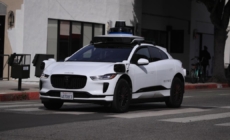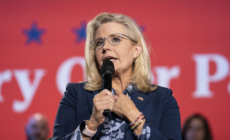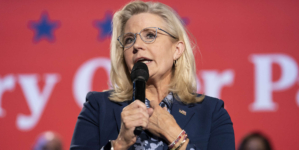-
Which Traditional Flu Remedies Work? Nutritionist Explains - 7 mins ago
-
Man who tried to take over self-driving taxi taken into custody in downtown L.A., police say - 38 mins ago
-
Does Josh Allen or Lamar Jackson have the better MVP case after 17 weeks? | The Facility - 41 mins ago
-
Justin Bieber’s Wife Hailey Shares Rare Glimpse of Jack - 48 mins ago
-
The stakes couldn’t be higher in rare Vikings-Lions Week 18 showdown - about 1 hour ago
-
Woman’s theory on the color pink sparks viral debate - about 1 hour ago
-
January is National Hobby Month — Here are three easy ones to start - 2 hours ago
-
Stray Dog Chases Down Woman’s Car, Tears Over What Happens Next - 2 hours ago
-
Is it right for the Eagles to sit Saquon Barkley short of the record? | Breakfast Ball - 2 hours ago
-
China targets dozens of U.S. companies ahead of anticipated Trump tariffs - 2 hours ago
Biden-Harris Climate Efforts Are Working. We Need More Next Term | Opinion
Imagine it’s Jan. 20, 2025. On her first day in office, President Kamala Harris announces a plan to fight the climate crisis in her first 100 days by cutting people’s energy costs and building an American clean industrial renaissance.
A congressional consensus coalesces: The climate-concerned who know we have five short years to bend our emissions curve join moderates who know we must onshore manufacturing and position America to beat China in leading tomorrow’s global economy. They pass legislation unleashing the opportunity economy that delivers what America—and the world—so badly needs: bold leadership for safety, health, and prosperity.
Within a decade, the United States becomes the clean economy’s global leader. Factories making clean steel, aluminum, and vehicles spring up across the country as corporations invest trillions, but this time without spewing pollution into our communities. Inflation falls as families unshackle themselves from volatile fossil fuels, which are core contributors to inflation. GDP booms by hundreds of billions per year, creating millions of new jobs paying good wages. Greenhouse gas emissions plummet, putting us on track for a safer climate future.
FREDERIC J. BROWN/AFP via Getty Images
This is the second chapter of U.S. climate leadership, building on momentum from the Inflation Reduction Act (IRA). In two years, the IRA has fueled a nationwide clean economic boom, showing policymakers they no longer must choose between a strong economy and a safe climate future where fewer of our kids have asthma. We can have both.
You easily could have missed it – about half of Americans did – but the IRA is now changing lives, putting money back into people’s pockets and creating career opportunities in clean energy manufacturing.
When Harris cast the deciding vote and President Joe Biden signed the IRA into law in 2022, they took the largest step forward on climate in American history. We were part of the long and fraught IRA climate policy negotiations, one of us in Senate Majority Leader Chuck Schumer’s office and one of us in the White House, where we helped formulate the strategy to pass this historic climate legislation by making climate action an opportunity for prosperity, instead of a sacrifice.
That strategy is now bearing fruit. Since the IRA passed, $500 billion dollars of investment has flowed into our communities—a more than 70 percent increase compared to the two years preceding the law. In the last year alone, Michigan received $6 billion in new investment, Georgia secured $8 billion, and North Carolina netted $10 billion. The IRA is also cutting energy bills—2.4 million Americans have claimed $8.4 billion in tax credits that cut their energy costs, saving families hundreds of dollars per year on their energy bills.
But the IRA isn’t the end of this story. It’s true the Biden-Harris administration took the largest-ever step forward on climate, but it’s also true we are still short of what the world’s scientists say is necessary to avoid a future where extreme weather events like hurricanes Helene and Milton get more catastrophic every year.
America’s current commitment is cutting climate pollution at least in half by 2030 and reaching net zero before 2050, in line with the trajectory scientists say is necessary for a safe future. In the past four years we have doubled the pace of emissions reductions.
But we must double the pace again, which will require the next administration to enact policies two- to three-times the IRA’s size. And it must happen in 2025, because new federal policy takes years to shift the trajectory of our massive economy.
The challenge before us is daunting. But Americans know how to do hard things, and winning on climate will supercharge our economy because clean energy is now cheaper than fossil fuels and far less susceptible to wild price swings than oil or gas. Politicians who want to double down on fossil fuels must be willing to do so at the expense of our economy and our pocketbooks. It is better for our economy, health, and quality of life to save our planet than to burn it.
Policy that builds on the IRA could have two pillars: Expand the industrial renaissance we have just begun to catalyze, and cut monthly bills by making it easier for families and businesses to access clean energy and equipment.
On the industrial renaissance: America is surging in the $1.8 trillion global race to win clean energy manufacturing. But what if we reclaim our global leadership in other heavy industries, and do it cleanly?
Industrial manufacturing—particularly steel, cement, and chemicals—is on track to be the world’s largest source of climate pollution within a decade. Meanwhile, America now produces less of the world’s demand for these critical goods than we use, right when global demand is rapidly growing.
It’s time to invest in our domestic heavy industries. Modern factories running on clean energy, clean heat, and innovative low-emissions manufacturing processes will position America to win the clean economic global race. Pollution tariffs that ensure we don’t import dirty industrial products made elsewhere will protect American workers who show up to work each day at our fleet of clean factories.
On cutting bills: We’re at the cusp of a new trend where clean energy is cheaper than fossil fuels in most parts of the country.
The last two years have seen a rush to build more solar, wind, and battery projects—the total volume of clean energy now waiting to connect to the U.S. grid would double our power system’s capacity. But that rush has created a huge backlog while proposed projects wait to connect to the electric grid, blocking affordable electricity from reaching Americans. Existing technology and creative policy can fix this, building on the IRA.
It’s also now cheaper to heat and cool our buildings with electric heat pumps than with fossil fuels in most parts of the country, but the up-front costs of this technology are still too high for many consumers. Reforming incentives for this vital equipment can help more families and businesses install them and cut their bills – even in chilly Maine, America’s “heat pump capital.”
Electric vehicles are also now the most affordable option. They are cheaper to fill up than gasoline cars in every state, and cost less to own. The best part is they keep getting cheaper—long-range electric vehicles now cost less to buy than gas cars. Charging stations are now widespread, but not ubiquitous. To make the choice a no-brainer for Americans, federal policy can help built more – and more reliable – charging stations.
America is fast becoming a global leader in producing the technologies powering the clean economy. We have an opportunity to transform and grow iconic heavy industries—and exporting our clean products will boost our domestic industries while cutting pollution worldwide.
When voters make their choice in a few weeks, the leaders they elect will either reverse course, or demonstrate America’s unbridled capacity by unleashing our innovators and entrepreneurs to win the race for the clean economy.
We’ve got work to do, but with climate leadership, America is ready to get the job done.
Adrian Deveney was Senate Majority Leader Charles Schumer’s director of energy and environmental policy, leading IRA negotiations about climate investments on the senator’s behalf. Sonia Aggarwal was special assistant to President Joe Biden for climate policy, innovation, and deployment, developing the IRA from the White House. We spent many hours together working to pass this law, building on decades of work by so many incredible leaders.
The views expressed in this article are the writer’s own.
Source link






























